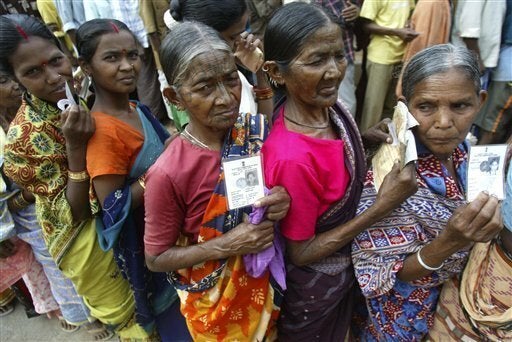
On April 16, the largest exercise of the democratic franchise in history began taking place, as Indian voters headed to the polls to elect a new national Parliament. They have done this 14 times since India gained its independence in 1947. Each time India has voted has been the world's largest exercise in electoral democracy. India's growing population is why the country keeps breaking its own voting record in terms of numbers.
This time, the electorate includes 714 million voters, an increase of 43 million over the previous general election in 2004. Votes will be cast in 828,804 polling stations scattered throughout the country for over 5,000 candidates from seven national political parties and several state and other parties. The process involves 4 million electoral officials and 6.1 million police and civilian personnel.
The numbers involved are so huge that the elections will be staggered over five phases, ending only on May 13, with electoral and security personnel being moved from state to state as polling is concluded in each place. Despite the phased voting, the counting takes place nationwide immediately after the last phase, and the results of the elections everywhere will be announced on May 16. A new Parliament will be convened on June 2 to elect a national government to succeed the outgoing administration of Prime Minister Manmohan Singh.
India's elections, conducted by the autonomous (and all-powerful) Election Commission of India, are an extraordinary event, and not just because of their sheer scale. It takes the felling of a sizable forest to furnish enough paper to print the 714 million ballots used in the voting process, and every election has at least one story of officers battling through snow or jungle, or traveling by elephant and camel, to ensure that the democratic wishes of remote constituents are duly recorded. (There is even one polling booth for a single voter, who lives much too far from civilization to travel to another polling station.)
Nor is any Indian election complete without the media publishing at least one picture of a female voter whose enthusiasm for the suffrage is undimmed by the fact that she is old, blind, crippled, toothless, purdah-clad, or any combination of the above.
The exotic aspects of the Indian elections do not end there. Because so many voters happen to be illiterate, India invented the party symbol, so that voters who could not read the name of their candidate could vote for him or her anyway by recognizing the symbol under which they campaigned. Symbols range from the open palm of the ruling Indian National Congress to the lotus of the Bharatiya Janata Party and variants of the hammer and sickle for India's profusion of Communist parties.
Independent candidates can choose from an assortment of alternatives, ranging from a cricket bat to images of various large animals. (Small ones were removed from the list when one candidate, running against another whose symbol was a parrot, wrung the neck of a live parrot at a public meeting to signify what he would do to his rival.)
India was also the first country to use an indelible stain on the voter's fingernail to signify that he or she had already cast a ballot. At every election, someone "discovers" a new chemical that will remove the stain and permit voters to vote twice, though this is unlikely to make a great difference in constituencies that are the size of those in India, where each Member of Parliament represents more than 2 million people. Likewise, some distinguished voter invariably claims that his name is missing from the rolls, or that someone has already cast his vote (but usually not both).
In any case, India's elections also happen to have a reputation for honesty. In this year's election, as in previous ones, votes will be cast on electronic voting machines that were invented in India, which combine the virtues of simplicity, reliability, and ruggedness. The electoral rolls carry photographs of every individual voter, as does each voter's identity card.
Elections have also been increasingly free of violence in recent years. There was a time when, in certain parts of India, workers could stuff ballot boxes for a candidate and political parties could "capture" polling booths. Electronic voting machines and strict security arrangements have largely eliminated that possibility. It has been some time since there were reports of the occasional election worker, candidate, or voter being assaulted, kidnapped, or shot. Nothing (short of the death of a major contender) interrupts the electoral process.
Elections are an enduring spectacle of free India, and have provided foreign journalists with the opportunity to remind the world that India remains the world's largest democracy. Indeed, Indians now take for granted that elections will take place, that the process will be free and fair, and that they will result in actual transfers of power in Delhi.
There are few developing countries in the world where this is true, and fewer still where poverty and illiteracy are both rife. That may be the real miracle of what will occur in India over the next few weeks into May.
This article was previously published on April 20, 2009 by Project Syndicate.

